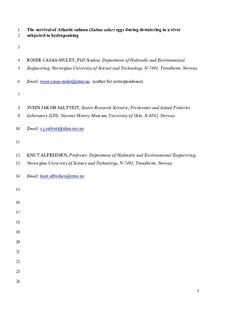| dc.contributor.author | Casas-Mulet, Roser | |
| dc.contributor.author | Saltveit, Svein Jakob | |
| dc.contributor.author | Alfredsen, Knut | |
| dc.date.accessioned | 2018-03-12T09:10:08Z | |
| dc.date.available | 2018-03-12T09:10:08Z | |
| dc.date.created | 2014-08-22T21:35:31Z | |
| dc.date.issued | 2015 | |
| dc.identifier.citation | Rivers Research and Applications: an international journal devoted to river research and management. 2015, 31 (4), 433-446. | nb_NO |
| dc.identifier.issn | 1535-1459 | |
| dc.identifier.uri | http://hdl.handle.net/11250/2490036 | |
| dc.description.abstract | Hydropeaking in regulated rivers is likely to become more frequent with increasing demands for renewable energy. Sudden fluctuations affect surface and subsurface flow regimes and change hydrological interactions occurring in the hyporheic zone. The hyporheic zone plays an important role for salmon embryonic development, and groundwater influx may create refuges for egg survival during low flow in hydropeaking regulated rivers. The links between salmon embryo survival and hyporheic hydrological processes during hydropeaking have hardly been investigated.
A field experiment was undertaken in a 5 × 20 m side gravel bar subject to dewatering due to hydropeaking. Eleven cylindrical boxes composed of eight compartments were placed in the permanently wet area and the ramping zone. Sixty eggs were placed in two compartments (at 10 and 30 cm depth) in each box. Surface and interstitial water levels and temperatures were monitored at 2 min resolution. Data were collected for a period of 3 months, coinciding with early stages of salmonid egg development in this catchment. Egg compartments were checked on six occasions for survival after different hydropeaking events. Dead eggs were counted and removed. Survival rates were lower in the top compartments in the ramping zone (78%) compared with the boxes in the permanently wet area and the lowermost compartments in the ramping (survival rates >99%). With no water quality issues in the catchment and very low inputs of fine sediments in the egg compartments, exposure to dry conditions and subzero temperatures were the main factors explaining egg mortality in the top compartments of the ramping zone. The rate of survival will thus depend on the surface water and groundwater interactions. Site-specific hydrological interactions occurring in the hyporheic zone should be actively considered when managing fish populations in rivers with hydropeaking. | nb_NO |
| dc.language.iso | eng | nb_NO |
| dc.publisher | Wiley | nb_NO |
| dc.title | The Survival of Atlantic Salmon (Salmo salar) Eggs During Dewatering in a River Subjected to Hydropeaking | nb_NO |
| dc.type | Journal article | nb_NO |
| dc.type | Peer reviewed | nb_NO |
| dc.description.version | acceptedVersion | nb_NO |
| dc.source.pagenumber | 433-446 | nb_NO |
| dc.source.volume | 31 | nb_NO |
| dc.source.journal | Rivers Research and Applications: an international journal devoted to river research and management | nb_NO |
| dc.source.issue | 4 | nb_NO |
| dc.identifier.doi | 10.1002/rra.2827 | |
| dc.identifier.cristin | 1148891 | |
| dc.relation.project | Norges forskningsråd: 193818 | nb_NO |
| dc.description.localcode | This is the peer reviewed version of the following article: [The Survival of Atlantic Salmon (Salmo salar) Eggs During Dewatering in a River Subjected to Hydropeaking], which has been published in final form at [http://onlinelibrary.wiley.com/doi/10.1002/rra.2827/abstract;jsessionid=610CBA0A377679B9552239E0E4DEC776.f03t01]. This article may be used for non-commercial purposes in accordance with Wiley Terms and Conditions for Self-Archiving. | nb_NO |
| cristin.unitcode | 194,64,91,0 | |
| cristin.unitname | Institutt for bygg- og miljøteknikk | |
| cristin.ispublished | true | |
| cristin.fulltext | postprint | |
| cristin.qualitycode | 1 | |
